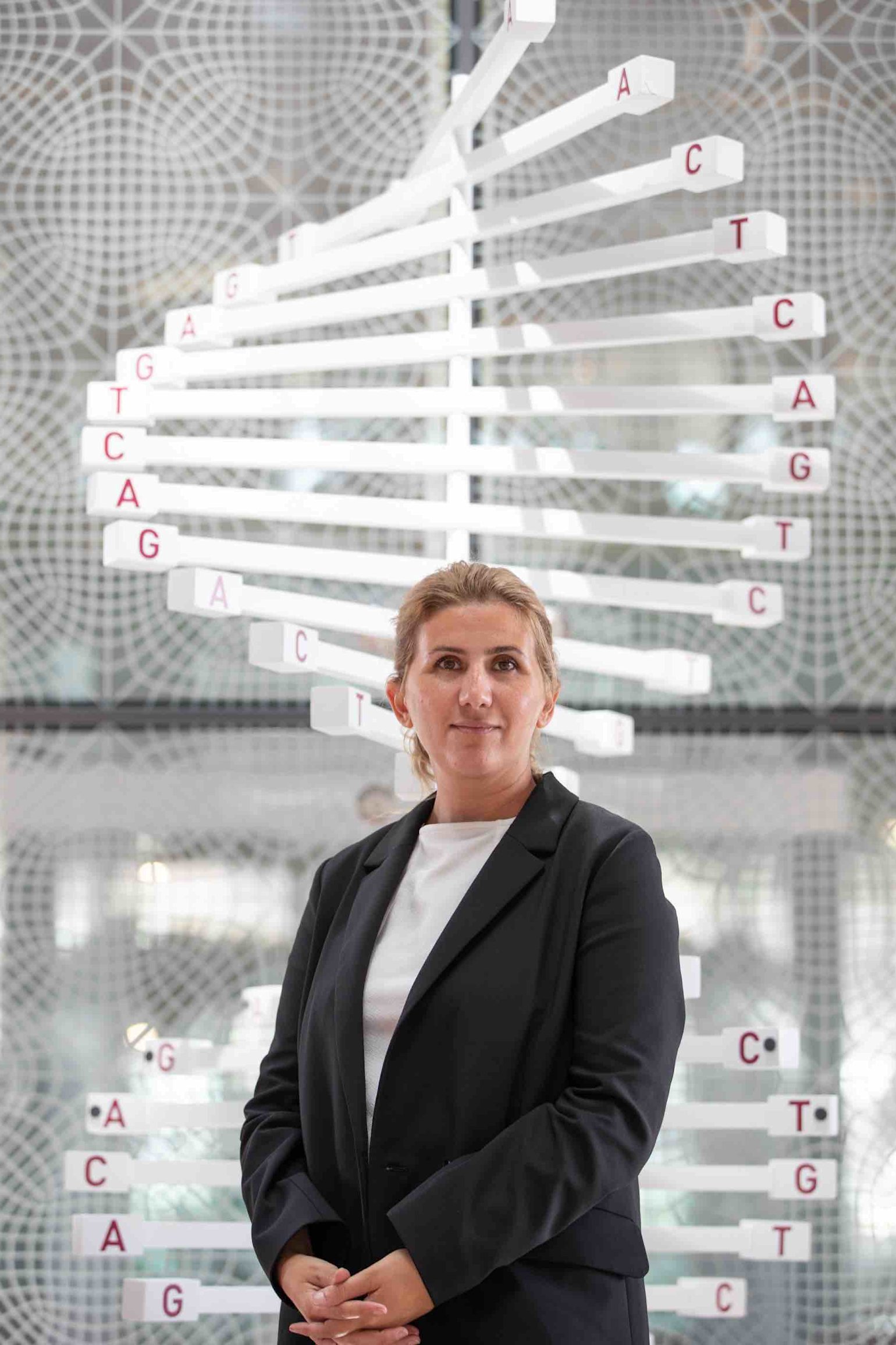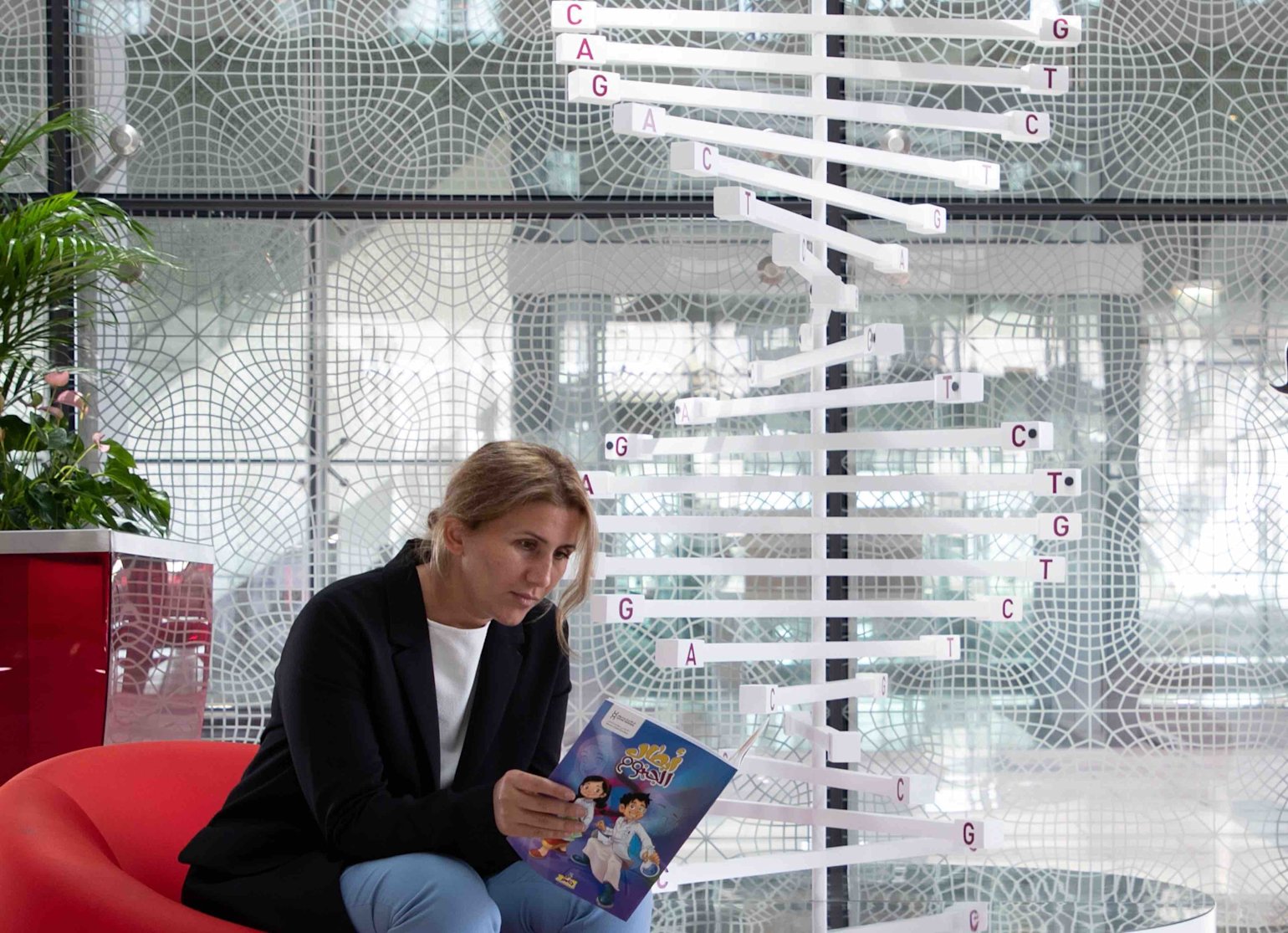Coronavirus (COVID-19) Updates
For the latest COVID-19 information and updates from Qatar Foundation, please visit our Statements page

Darwish hopes children reach a stage where they can dream of becoming a doctor or researcher in genomics, instead of limiting their choices to fields such as engineering, business, and teaching.
Dima Darwish from Qatar Genome talks about what prompted her to create this comic strip and what it aims to achieve
One day as she returned from work, Dima Darwish, Head of Scientific Education at Qatar Foundation’s Qatar Genome Programme, was caught without an answer when one of her children asked about the nature of her work. Always the expert, she struggled for words to describe her job to her a four year-old.
Qatar Foundation is leading the charge to develop Qatar Genome Program, the largest genome project in the Middle East, with real benefits for the local and regional population
“It was this simple question that helped me realize how difficult it is for younger children to understand genomics. As experts, we have been working with the community to map the Qatari genome – a top priority for Qatar and the region – and yet here we are, still unable to effectively communicate basic information about genomics to children,” Darwish says. And this is what inspired her to create and develop Genome Heroes – an Arabic comic strip that aims at making the science of genomics understandable to younger children.

Dima Darwish, Head of Scientific Education at Qatar Foundation’s Qatar Genome Programme.
Qatar is among leading countries, in the world, in the field of precision medicine, and is building a dynamic research sector around it, which has triggered real interest in designing, planning, and preparing the next generation of precision medicine professionals.
“Qatar Foundation is leading the charge to develop Qatar Genome Program (QGP), the largest genome project in the Middle East, with real benefits for the local and regional population,” Darwish says. “A key objective of Genome Heroes is to prepare the next generation of professionals in genomics. In the future, there will be local and global demand for precision medicine specialists, geneticists, genetic counsellors, bioinformaticians, and more such specialists.”
A key objective of Genome Heroes is to prepare the next generation of professionals in genomics
Introducing this knowledge to younger children raises their awareness and passion for genetics, leading them to eventually pursue academic and professional paths in this field. And the lack of Arabic science content is another reason why Darwish created Genome Heroes. This project aims to enrich the vocabulary of children in Qatar and the Arab world, while also increasing their passion for the Arabic language.
There is an urgent need to develop Arabic science content for children. Many scientific topics such as genetics simply aren’t covered in Arabic
“There is an urgent need to develop Arabic science content for children. Many scientific topics such as genetics simply aren’t covered in Arabic,” Darwish says. “At the start of COVID-19 outbreak, we couldn’t find any Arabic content for children about the pandemic. Hence, we decided to produce a story on the pandemic with Dana and Khalid being its main characters. It was well received.”
Darwish added that as part of the cooperation between Genomics England and QGP, the center has asked to allow its doctors to use the comic strip to educate Arab children about this pandemic.
Genome Heroes is published in Jassim Kids Magazine, and the siblings– Dana and Khalid – the illustrated stories provide simple facts about genomics in a fun way. Genome Heroes is available on the QGP website, Qatar Foundation (QF) schools, and the Qatar National Library among others.

Example of Genome Heroes series that published in Jassim Kids Magazine. 14 stories have been released so far and are directed at the age group from 5 to 10 years.

“Children and parents are excited about these stories. It’s not true that children, as we have always believed, can’t process the sophisticated language of science. Nowadays, children use technology terms frequently, and due to their exposure to digital media, they are downloading and using complicated software applications which have become part of their daily lives,” Darwish says.
She also noted that children prefer to learn by doing, rather than passive learning. “This hands-on learning approach enhances their understanding and rewards their curiosity.” And this is why Darwish dedicates some of her free time to educating high-school students on genetics, opening their eyes to the potential of the field.
“As a part of QGP and QF’s Qatar Biobank training programs, we offer tour experiences to students of different age groups, including ‘DNA: Journey to the Heart of Life’, an exhibition in Bin Julmood Museum, located within Msheireb Museums. In this tour, we organize a workshop in which each child plays the role of a genome specialist, such as a genomic researcher, genetic counsellor, or a doctor.
“Dressed as real characters, each child does a specific job. For example, the researcher takes a sample of fake blood, then the sample goes to the bioinformatics specialist who analyzes it in a computer before a report on the genome is made and explained to students. We also make the principles of genetics more accessible to children through animated cartoons inspired by their environment. These activities help extend children’s knowledge, and increase their passion for genetics.”

Darwish hopes that one day children can choose genetics as a career path. “We explain to children how a strawberry, for example, contains DNA just as human cells do, and how DNA determines our characteristics, such as the colour of our hair and eyes, and even our talents. Such activities help spark their curiosity.”
Darwish hopes children reach a stage where they can dream of becoming a doctor or researcher in genomics, a genetic counselour or a bioinformatician, instead of limiting their choices to fields such as engineering, business and teaching.
She says: “We want them to know that there are wonderful and interesting sciences like precision medicine and genetics, and to consider them when they plan for their future.”

